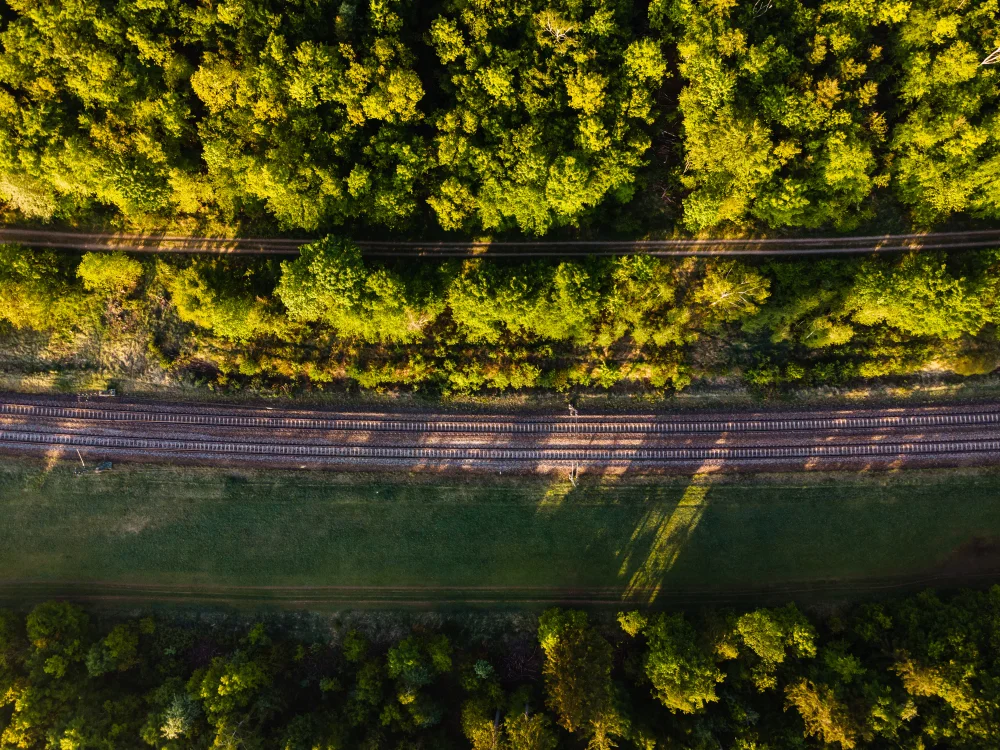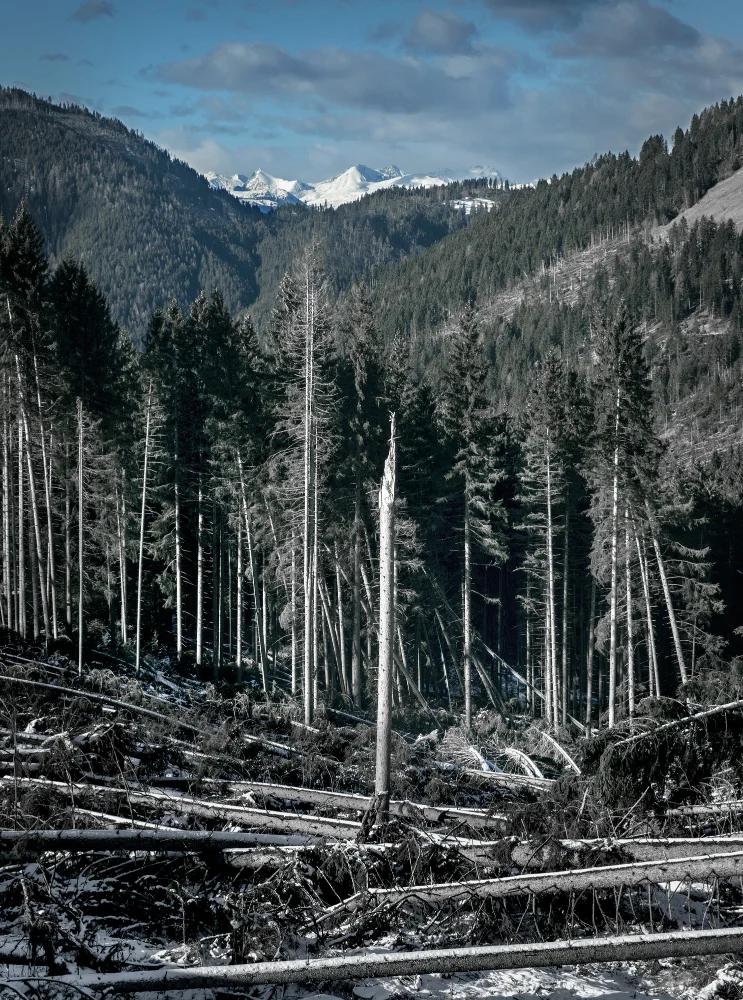No two sites are the same. A logging track on a steep forest hillside has different needs from a solar farm in an open plain, and a live railway line demands a very different approach to a municipal park or a storm-hit coastline.
Using heavy duty mulchers allows vegetation to be managed with a balance of power, precision, and environmental care, ensuring that each environment remains safe, accessible, and compliant throughout the year.
Whether the objective is to maintain operational continuity, protect sensitive ecosystems, or enable rapid recovery after natural events, this equipment can be deployed in ways that match the specific regulations, terrain conditions, and priorities of each sector.

In forestry environments, vegetation management demands a careful balance between operational efficiency and environmental stewardship. Clearing too aggressively can strip the land, heighten erosion risks, and delay natural regeneration, while insufficient control can create hazards and limit productivity. A well-planned approach ensures forestry operations remain efficient, compliant, and environmentally responsible throughout the year. In managed woodlands, heavy-duty mulching offers a highly effective method for opening skid trails, thinning dense undergrowth, and removing ladder fuels that contribute to wildfire spread. Unlike traditional clearing methods that may require multiple passes and create large piles of debris, mulching processes vegetation directly where it falls, leaving a protective layer of organic matter that benefits the soil and surrounding ecosystem.
This mulch layer slows rainwater runoff, reduces erosion risks on steep or sensitive slopes, and retains valuable soil moisture to help establish young saplings. As it decomposes, it returns essential nutrients to the ground, improving conditions for future timber stands. For more challenging terrain, such as wetlands, rocky areas, or steep gradients, using low ground pressure machinery with precise cutting capabilities prevents rutting and soil compaction, ensuring the land’s long-term health is preserved. From selective harvest areas and habitat restoration efforts to large-scale clearance for logging transport corridors, professional vegetation control plays a pivotal role in keeping forestry sites safe, productive, and ecologically balanced.
Utility corridors, whether carrying high-voltage power lines, pipelines, or fiber optic cables, require year-round vegetation management to ensure safety, accessibility, and uninterrupted service. Overgrown trees and brush can cause major disruptions, from triggering power outages during storms to blocking maintenance crews during emergencies. Proactive vegetation control reduces these risks, extends the operational life of infrastructure, and ensures compliance with strict regulatory standards. In many jurisdictions, vegetation clearance near transmission lines is legally mandated to prevent electrical faults and mitigate wildfire risks. Mulching provides an efficient solution by removing overgrowth in place while leaving a protective layer of organic material that slows regrowth, reduces maintenance frequency, and helps maintain corridor readiness with fewer interventions.
The ability to process dense brush, saplings, and invasive species without the need for hauling or chipping significantly lowers labor, fuel, and transportation costs. Compared to other mechanical clearing methods, mulching disturbs the soil far less, preserving root systems and reducing erosion along the corridor. Utility pathways often traverse diverse landscapes including agricultural land, forests, and wetland areas. Modern mulching equipment can adapt seamlessly to these changing conditions without the need to switch machinery, ensuring consistent performance in both remote and hard-to-reach zones. Low ground pressure systems are especially valuable in sensitive environments, as they reduce environmental impact while upholding safety clearances. When integrated into a planned vegetation management program, strategic mulching helps utilities remain compliant, safeguard critical infrastructure, and maintain uninterrupted operations across entire networks.
Keeping pipeline corridors clear is essential for safety, inspection access, and regulatory compliance. Overgrown vegetation can hide hazards, restrict maintenance crews, and delay emergency response.
Mulching offers an effective solution by processing brush and saplings in place, creating a mulch layer that stabilises soil, prevents erosion, and slows regrowth. This reduces clearing frequency and long-term maintenance costs while protecting slopes, wetlands, and sensitive habitats.
With the ability to work across varied terrain using low-impact equipment, mulching ensures that pipelines remain accessible, visible, and environmentally secure year-round.

Firebreaks serve as essential barriers that slow or stop the advance of wildfires, giving firefighting teams the space and time they need to respond effectively. Through targeted vegetation removal, mulching creates clear, low-fuel zones that disrupt fire paths and reduce the risk of flames jumping into vulnerable areas.
Instead of leaving combustible debris that could reignite, the process leaves a fine mulch layer that retains soil moisture and further reduces ignition potential. These breaks are strategically placed and sized to fit each site’s terrain, prevailing winds, and vegetation type.
From rural town borders to industrial facilities and conservation reserves, this approach delivers year-round wildfire readiness while maintaining soil stability and protecting local wildlife habitats.
Post-wildfire recovery requires quick action to limit further environmental degradation and make affected areas safe and accessible again. Mulching plays a central role in this process by removing burned and unstable vegetation while leaving behind an organic layer that shields the soil from erosion, traps moisture, and encourages native plant regrowth. This protective layer not only helps stabilise slopes and streambanks but also reduces sediment runoff into waterways, protecting aquatic habitats downstream. By processing debris in place rather than hauling it away or burning it, recovery crews can work faster, reduce costs, and preserve valuable nutrients in the soil. Whether restoring access to utility corridors, preparing land for replanting, or rehabilitating wildlife habitat, mulching supports both immediate safety needs and long-term ecosystem recovery.
In renewable energy installations, consistent vegetation management is essential to protect infrastructure, maximise energy output, and maintain site accessibility. Around solar arrays, unchecked plant growth can cast shadows on panels, reducing efficiency and increasing cleaning requirements due to pollen or seed debris. In wind farms, overgrown access roads and turbine bases can slow maintenance crews, obstruct safety inspections, and create unnecessary fire hazards in dry seasons. By keeping these areas clear, operators can ensure uninterrupted access for technicians, preserve clear sightlines for safety monitoring, and minimise the risk of damage from invasive root systems or falling branches. The mulch layer produced during clearing also delivers valuable environmental benefits. It helps prevent erosion on slopes surrounding solar fields, reduces dust that can settle on panels and lower output, and supports soil moisture retention to encourage low-maintenance native ground cover. Whether managing a compact community solar installation or a sprawling offshore wind support facility, well-planned vegetation control maintains operational efficiency while demonstrating responsible land stewardship.
Public spaces such as parks, sports grounds, walking trails, and roadside verges require consistent vegetation management to remain welcoming, functional, and safe for all users. Overgrown areas can block sightlines for drivers and cyclists, limit accessibility for pedestrians, and create potential hazards during emergencies. Strategic mulching addresses these issues by clearing excess growth quickly and evenly, without leaving hazardous debris piles. The resulting mulch layer keeps soil stable, suppresses rapid regrowth, and reduces the need for frequent interventions, which helps municipalities control maintenance budgets while keeping spaces in top condition. By integrating mulching into regular schedules, public works teams can keep high-traffic areas accessible year-round, ensure compliance with safety regulations, and preserve the aesthetic appeal of shared green spaces for residents and visitors alike.
In mining and extraction environments, uninterrupted access and hazard prevention are non-negotiable. Overgrown vegetation can quickly block haul roads, conveyor paths, and security perimeters, slowing down production and creating safety risks for operators of heavy vehicles and equipment. Encroaching roots can undermine building foundations, pipelines, and buried cables, while dry brush near active work zones significantly increases the risk of fires, especially in arid or windy regions. By implementing regular, targeted vegetation management, sites can maintain clear access routes, preserve visibility for security patrols, and keep critical infrastructure free from damage. Efficient land clearing also plays a role in environmental compliance. Mining operations often operate near protected habitats, watercourses, or dust-sensitive areas, and overgrowth can disrupt drainage patterns, leading to erosion or contamination risks. Processing vegetation on-site into mulch stabilises soil, limits dust generation, and prevents invasive plants from taking root, all while eliminating the need for large-scale debris hauling. This approach reduces fuel consumption, minimises disruption to surrounding ecosystems, and aligns with environmental management plans required by regulators. From active extraction pits to storage yards and buffer zones, a consistent vegetation control strategy ensures that mining operations remain safe, productive, and in full compliance with industry and environmental standards.

Transport corridors are the arteries of commerce and mobility, and their safety depends heavily on effective vegetation management. Overgrown brush, tall grass, and encroaching trees can block driver sightlines, obscure railway signals, and create hazards for maintenance and emergency crews. Along both roadsides and railways, uncontrolled growth also increases the risk of fires, especially in hot, dry climates where sparks from vehicles or trains can ignite dry vegetation within seconds. Keeping these corridors clear is not simply a matter of aesthetics, it is a fundamental requirement for public safety, operational efficiency, and infrastructure protection.
Strategic vegetation control ensures unobstructed views for drivers, train operators, and signal personnel, reducing the likelihood of collisions or operational delays. Processing vegetation directly in place creates a mulch layer that suppresses regrowth and retains soil moisture, meaning maintenance teams can extend the intervals between clearing cycles. This reduces not only labour and fuel costs but also the environmental impact of repeated heavy equipment use.
When storms hit, the combination of fallen trees, scattered branches, and damaged vegetation can create serious hazards for communities. Roads may be blocked, power lines downed, and public spaces rendered unsafe for use. Effective storm cleanup is about more than restoring order, it is about removing immediate dangers, reopening critical infrastructure, and supporting the long-term recovery of the affected landscape.
The first priority in post-storm operations is clearing emergency access routes for ambulances, fire services, and repair crews. Large debris, leaning or unstable trees, and tangled vegetation must be removed quickly to prevent secondary accidents and to allow utilities to restore electricity, water, and communication services. By processing debris directly on site, mulching reduces the need for hauling and disposal, speeding up the reopening of roads and public areas while avoiding the creation of hazardous debris piles.
Mulching also provides important environmental benefits in the aftermath of extreme weather. Leaving the processed organic matter in place creates a protective layer that prevents soil erosion, helps retain ground moisture, and encourages the regrowth of native vegetation. This method not only speeds ecological recovery but also prevents invasive species from taking hold in disturbed areas.
Whether dealing with urban parks, rural access roads, or critical utility corridors, a well-planned storm cleanup strategy restores safety, minimises downtime, and contributes to the resilience of both infrastructure and the surrounding environment.


If you are ready to get the right vegetation management solution for your land, let’s talk. We can put together a plan that’s made for your site, your timelines, and your priorities, whether that’s keeping operations running smoothly, protecting the environment, or cutting down on maintenance headaches. You will get a clear schedule, practical recommendations, and an approach that actually works on the ground.
Request your custom vegetation management plan today (link to quote page) and see how we can help you keep your land in top shape all year.
“Every site has its own challenges, but with the right plan and the right equipment, there’s no reason vegetation should ever slow you down. Our goal is simple, keep your land safe, accessible, and working for you year-round.”
Heavy-duty mulching is used in a wide range of industries, from forestry to utilities, transport corridors, and post-disaster recovery.
Below, we answer the most common questions about where, when, and how mulching can be applied to keep land safe, accessible, and compliant.
Heavy-duty mulching can be applied to forestry, utility corridors, pipeline rights-of-way, firebreak creation, post-fire restoration, municipal land management, renewable energy sites, mining areas, military zones, transport corridors, and storm cleanup. The method adapts to different terrains and vegetation densities, making it a versatile option for both public and private sectors.
Unlike methods that cut and haul vegetation, heavy-duty mulching processes material directly where it falls, turning it into a protective mulch layer. This reduces erosion, retains soil moisture, and slows regrowth, all while cutting down on labor, hauling costs, and environmental impact.
Yes, when done correctly, it can be an eco-conscious choice. Mulching preserves root systems, protects soil from erosion, encourages native plant regrowth, and reduces the need for chemical vegetation control.
With the right equipment and experienced operators, mulching can be performed in wetlands, wildlife habitats, and cultural heritage sites while minimizing disturbance. Low ground pressure machines and precise cutting heads are often used to protect fragile environments.
Frequency depends on local climate, vegetation type, and regulatory requirements, but many corridors benefit from seasonal or annual maintenance to ensure visibility, safety, and compliance.
Absolutely. Mulching is often part of wildfire mitigation plans because it removes combustible vegetation, creates defensible spaces, and helps maintain clear firebreaks.
Depending on the machine, heavy-duty mulchers can process material from light brush to fully mature trees. The choice of equipment will depend on the site’s vegetation density and project goals.
Yes, mulchers are ideal for post-storm and post-fire recovery. They quickly clear debris, reopen access routes, stabilize soil, and encourage regrowth without the need for burning or extensive hauling.
In some areas, yes. Projects in protected habitats, near waterways, or in utility easements may require permits. It’s important to check with local authorities or land managers before starting work.
The best method depends on your land type, vegetation, environmental constraints, and project objectives. A site assessment can determine the ideal approach, ensuring safe, efficient, and sustainable vegetation management.
To provide the best experiences, we use technologies such as cookies to store and/or access device information. Consenting to these technologies will allow us to process data such as browsing behavior or unique IDs on this site. Failure to consent or withdrawing consent may adversely affect certain features and functions.